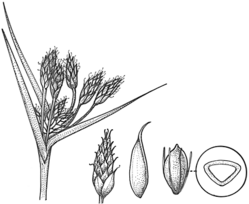Common name: marsh club-rush
Bolboschoenus fluviatilis (Torr.) Soják APNI* Synonyms: Scirpus fluviatilis (Torr.) A.Gray APNI*

Description: Rhizomatous perennial. Culms 100–200 cm high, 5–10 mm diam.
Leaves 7–11 mm wide.
Inflorescence with 6–9 branches 2–10 cm long, bearing clusters of 1–6 spikelets; involucral bracts 15–25 cm long, 3–6 mm wide. Spikelets 1–2.5 cm long. Glumes 6–7 mm long (plus mucro 1.5–3 mm long), yellow-brown. Hypogynous bristles about as long as nut, usually persistent. Style 3-fid.
Nut equally trigonous, with dorsal angle acute, 3–4 mm long, 1.5–2 mm diam., pale yellow or grey and dull to blackish and shining, minutely (but often obviously) reticulate.
Flowering: spring–summer.
Distribution and occurrence: Scattered, in open swamps; west to Macquarie Marshes.
NSW subdivisions: NC, CC, SC, CT, ST, NWS, NWP, SWP
Other Australian states: Qld Vic. S.A.
Differs from the other species in its relatively narrow nut with bristles about as long as nut and persistent. The main species in the critically endangered Marsh Club-rush sedgeland of the Darling Riverine Plains Bioregion of NSW - see http://www.environment.nsw.gov.au/determinations/marshclubrush36a.htm
Text by K. L. Wilson (1993); edited KL Wilson (April 2014)
Taxon concept: Flora of NSW 4 (1993)
APNI* Provides a link to the Australian Plant Name Index (hosted by the Australian National Botanic Gardens) for comprehensive bibliographic data
***The AVH map option provides a detailed interactive Australia wide distribution map drawn from collections held by all major Australian herbaria participating in the Australian Virtual Herbarium project.
|


